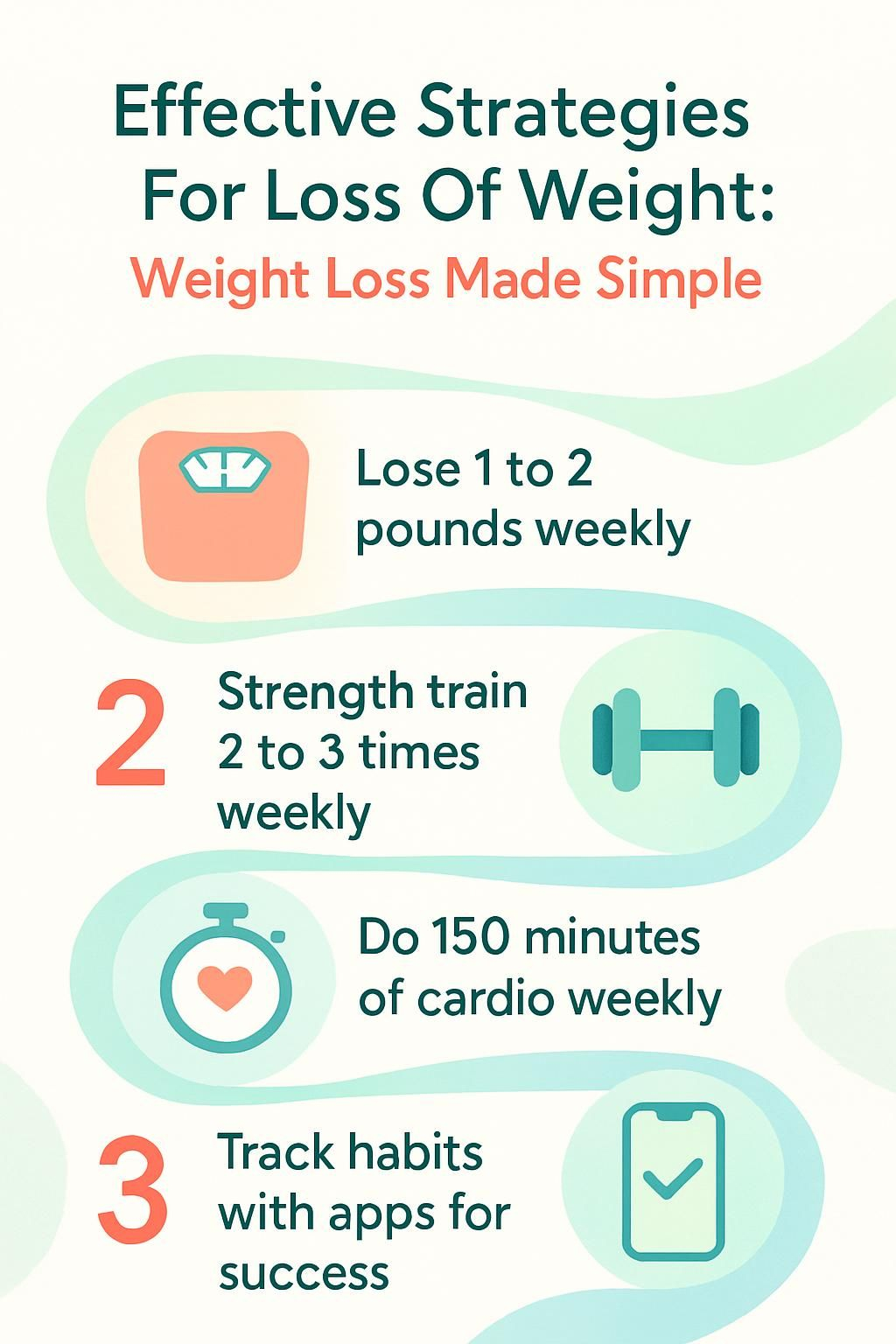Effective Strategies For Loss Of Weight: Weight Loss Made Simple
Our Nutrition Assistant AI Suite will transform your body. You will lose fat, get toned, and build muscle. Gain confidence and optimal health.
Struggling with weight loss can feel exhausting. You work hard, yet the scale barely moves. If unexplained weight loss happens without trying, especially more than 10 pounds in six to twelve months, speak with a clinician to rule out medical conditions like diabetes or thyroid disease.
This guide shows practical steps to manage body weight, set realistic goals, and avoid common pitfalls. You will find simple actions that make losing weight safer and easier, one small change at a time.
Key Takeaways
- Safe weight loss usually means 1 to 2 pounds per week and no more than 5 percent of body weight in six to twelve months.
- Unintentional loss of over 10 pounds, or more than 5 percent, deserves prompt medical evaluation for conditions such as diabetes, thyroid disorders, or cancer.
- Whole grains, lean protein, healthy fats, and fiber-rich vegetables support fat loss, reduce hunger, and help prevent nutrient gaps.
- Strength training two to three days weekly plus at least 150 minutes of cardio helps preserve muscle and supports steady fat loss.
- Tracking habits with apps, and building a support network, increases long-term success and keeps goals measurable.

Understanding Healthy Weight Loss

Healthy weight loss focuses on losing fat while keeping muscle. Clear, realistic goals reduce confusion, protect health, and help you spot warning signs of unintentional weight loss caused by illness.
What is healthy weight loss?
Healthy weight loss is intentional, gradual, and supports better health. Clinicians often call it significant when you lose more than 10 pounds or 5 percent of body mass within 6 to 12 months.
Fast drops in body weight, or losing more than 5 percent without trying, can signal a deeper issue. For example, an overactive thyroid, gastrointestinal disease, or cancer may cause changes in appetite, poor absorption, or muscle loss.
Involuntary weight loss means the loss happens without effort. That is a red flag. Safe change comes from a balanced eating pattern, regular activity, and support, not from illness or loss of appetite.
Daily shifts of a few pounds are common and not worrisome. The aim is to lose mostly fat and keep muscle. I once worked with a registered dietitian after experiencing unexplained weight loss; a full checkup found the cause, and treatment restored my energy.
“Significant unintentional weight loss can point to a serious medical condition and should prompt a full medical evaluation.”
With a solid definition in mind, you can set goals with confidence and clarity.
Why is setting realistic weight loss goals important?
Realistic goals protect you from risky drops in human body weight. A safe target is 1 to 2 pounds per week, adding up to no more than 5 percent of starting body mass in six to twelve months.
Rapid change often leads to nutrient gaps and muscle loss instead of fat loss. That can harm strength, bone health, and mood. Expectations that are too aggressive also fuel crash dieting and disordered eating. Older adults face higher risk and need close monitoring.
I once tried to lose ten pounds in a month after seeing a trend. The result was low energy and strong cravings. Research notes that about one quarter of unexplained weight loss cases remain undiagnosed, so reassess goals regularly and watch for symptoms.
If nausea, diarrhea, or other new issues appear while trying to lose weight, contact a healthcare provider. These signs can point to conditions such as Crohn’s disease or Addison’s disease.
Key Steps to Begin Your Weight Loss Journey
The first steps set the tone. Clear motives, honest tracking, and measured goals will help you lose weight safely and steadily.
How do I identify my motivation for losing weight?
Start with your why. Health motives, like lowering risk for type 2 diabetes or heart disease, tend to last longer than appearance-only goals.
Losing weight may ease high blood pressure, joint pain, or celiac disease symptoms. Many people notice better mood, more energy, and deeper sleep, which reinforces effort.
Separate planned weight loss from unintentional loss that can signal medical problems. Sources such as the Merck Manual note that unexpected loss can relate to gastrointestinal tract disorders, including Crohn’s disease and ulcerative colitis.
If you develop nausea, vomiting, diarrhea, or a clear drop in appetite while you are not trying to lose weight, seek medical care soon.
Clear motivation helps pave the way for safe weight management and sustainable results.
How can I track my current habits effectively?
Once your why is clear, track what you eat and how you move. Use a simple journal or an app to log meals, snacks, and activity. Real-time logging keeps data accurate and honest.
Weigh in weekly to spot trends. A drop greater than 5 percent of body weight in 6 to 12 months is a warning sign that deserves medical review.
Watch for skipped meals, reduced appetite, or changes in energy, mood, or digestion. These patterns can reflect hormone shifts or side effects from a prescription drug.
If sudden changes appear, ask a health care professional about blood tests or a physical examination. Tracking revealed my stress eating during tight work deadlines, and sharing logs with a dietitian led to a better plan.
How do I set achievable and measurable weight loss goals?
Use your tracking data to build specific goals. Target 1 to 2 pounds per week. For many adults, this range is both safe and effective.
As a guide, aim for a 5 percent reduction over six months. If you start at 200 pounds, a measured goal is to lose about 10 pounds in that period.
Use numbers, not vagueness. Track with weekly weigh-ins and waist checks. Break larger targets into milestones like two pounds per month or one clothing size per quarter.
Stay in touch with health professionals. Adults over 65, or those with conditions such as hyperthyroidism or coeliac disease, may need more frequent checks. Build habits around nutrient-dense foods and sleep so anxiety, medication effects, and metabolism shifts do not derail progress.
Effective Diet Strategies for Weight Loss
Food choices can work with your biology, not against it. Think of your plate as a simple tool for steady change.
What are nutrient-dense foods to focus on?
Nutrient-dense foods deliver vitamins, minerals, and protein without excess calories. Favor fruits and vegetables, lean proteins like poultry, fish, eggs, and legumes, plus whole grains such as brown rice and quinoa.
Protein protects muscle during weight loss, which matters more with age. Add healthy fats from avocados, nuts, seeds, olive oil, and fatty fish. These foods help you feel full and reduce snacking.
Avoid empty-calorie items high in sugar and saturated fat. They crowd out nutrition and can stall progress. If the small intestine struggles to absorb nutrients, as with inflammatory bowel disease or celiac disease, a nutrient-dense pattern helps fill common gaps.
After an autoimmune diagnosis, I shifted to lean protein and greens at each meal. Energy improved, and my vitamin levels normalized on follow-up labs.
How can I control portion sizes to lose weight?
Use smaller plates and bowls. A modest serving looks bigger, and many people eat less without feeling deprived.
Measure portions for calorie-dense foods like rice or pasta. Serving onto a plate, not from the package, prevents mindless overeating.
Eat slowly. It takes about 20 minutes for fullness signals to reach the brain. Adjust portions to match activity level, especially if you manage diabetes, metabolic conditions, or a history of obesity.
Mindful eating and reading labels help you manage calories while keeping nutrition strong.
Why should I limit processed foods and sugary drinks?
Processed foods and sugary drinks raise calorie intake fast. Many products come loaded with unhealthy fats, sodium, and syrups that do little for health.
Regular intake increases risk for diabetes, heart disease, peptic ulcer disease, and some cancers. A 12-ounce soda has about 39 grams of sugar, roughly 150 calories with no vitamins or minerals.
Cutting these items steadies blood sugar and reduces cortisol spikes. Swapping soda for water or unsweetened tea also supports gut health and reduces bloat. My energy rose within weeks after I made this switch.
These small swaps make appetite signals easier to manage and support steady fat loss over time.
How do healthy fats and fiber aid weight loss?
Healthy fats from avocados, nuts, and olive oil help you stay satisfied. These unsaturated fats support hormone balance, including cortisol and aldosterone, which influence hunger signals and storage.
Fiber from beans, fruits, and whole grains slows digestion and stabilizes blood sugar. That means fewer cravings and fewer calories across the day. High-fiber eating also supports regularity and gut health.
People who eat more fiber often lose more weight and feel fuller. Adding extra vegetables and legumes helped me snack less during long afternoons. For older adults or anyone with low appetite, fiber with healthy fats can help protect both fat and muscle stores.
The Role of Physical Activity in Weight Loss
Movement is a daily tool. It turns stored glucose into energy and lifts mood at the same time.
What are the benefits of regular exercise for weight loss?
Regular exercise raises daily calorie burn and helps preserve muscle while you lose fat. Stronger muscles protect joints and keep metabolism steadier.
Workouts improve insulin sensitivity and lower diabetes risk, especially for people with a family history. Cardio activities like brisk walking, cycling, and swimming support heart health and can reduce the risk of heart failure and chronic lung disease.
Active days fight the effects of long sitting, which raises risk for muscle loss and mood problems. Exercise also boosts mental health, easing anxiety and cutting stress-related appetite swings.
People are more likely to keep lost pounds off if they continue to exercise. A steady mix of strength and aerobic work supports long-term results.
What types of exercises help with weight loss?
Different activities bring different benefits. A blend usually works best.
- Aerobic exercises like walking, running, and cycling raise heart rate and burn calories. Thirty minutes of brisk walking can burn about 150 to 200 calories for a 155-pound person.
- Strength training with weights or bands maintains muscle while you lose fat. This is crucial for older adults who face faster muscle loss.
- Interval training alternates high effort with recovery. Studies show it can improve fat loss and cardio fitness more than steady moderate work.
- Flexibility and balance work, such as yoga or Pilates, supports function and lowers stress. Many people notice improved mood.
- Low-impact options like swimming or an elliptical protect joints for anyone with arthritis or a recent illness.
- Group classes or team sports add social support. People often stay motivated longer when they train with others.
- Weight-bearing activities like hiking or stairs build bone strength and reduce muscle loss after inactivity.
- Consistent routines are tied to better long-term outcomes, as noted in the Merck Manual of Diagnosis and Therapy.
Exercise works best alongside smart nutrition. Both matter.
How can I combine strength training and cardio effectively?
To maximize fat loss and keep muscle, plan both. Strength train two to three days per week, focusing on major muscle groups.
Add 150 minutes of moderate cardio each week. Alternate days to reduce injury risk and keep sessions fresh. If time is short, pair shorter strength circuits with brisk walks.
Track body composition, not just scale weight. Older adults, or anyone with conditions like Addison’s disease or HIV that can cause unintentional loss, should get medical clearance before starting.
Adjust based on how you feel and any medical advice. Blending both styles helps break plateaus and supports steady progress.
Lifestyle Changes to Support Weight Loss
Daily habits shape results. Small choices compound over time.
How can I manage stress to support weight loss?
Chronic stress shifts hormones and can raise appetite or suppress it. Many people cope with food, which disrupts plans and stalls progress.
Mindfulness, deep breathing, and brief relaxation breaks calm the body. Therapy can reduce anxiety, address unexplained weight loss linked to mood changes, and improve follow-through with your plan.
Short daily meditation helped me control cravings during busy workdays. Checking in on your mood helps you see how stress affects hunger, so you can respond early.
Why is quality sleep important for losing weight?
Too little sleep disrupts hunger hormones, ghrelin and leptin. After a bad night, many people feel hungrier and eat more.
Poor sleep also raises cortisol, which can promote fat storage and slow fat loss. If you lose more than 5 percent of your weight without trying and sleep is poor, get medical advice.
Adults need seven to nine hours each night. Good sleep hygiene lifts energy, supports recovery from exercise, and makes it easier to choose nutrient-dense foods instead of sugary snacks.
During a slow stretch in my own plan, tightening my bedtime routine improved workouts the next day and made meals easier to manage.
How much water should I drink to stay hydrated?
Water supports metabolism, digestion, and appetite control. A common target for adults is about 8 cups, or 64 ounces, per day. People who exercise more, or who are breastfeeding, may need extra.
Replacing sugary drinks with water cuts calories right away. Drinking water before meals may reduce portion sizes by boosting fullness.
Older adults often feel less thirst, which raises dehydration risk. Adequate hydration also supports urinalysis and helps keep the bladder healthy.
Behavioral Strategies for Success
Behavior change turns good intentions into daily practice. Simple tools help you stick with it.
What is mindful eating and how do I practice it?
Mindful eating means paying attention to hunger and fullness cues. Before a meal, check if you feel true hunger, like a hollow stomach or low energy.
Eat more slowly and chew thoroughly. I found that chewing about 20 times per bite helped me feel satisfied sooner. Keep phones and TV away from the table.
Logging how you feel before and after meals reveals patterns tied to stress or boredom. Mindful eating reduces binges and supports weight control over time.
How can I avoid emotional eating?
Use a food and mood diary. Track what you eat and how you feel before and after. Patterns often appear during stress, anxiety, or sadness.
Identify triggers like tight deadlines or conflict. Choose healthier coping skills: a short walk, music, a quick stretch, or a chat with a friend.
Set regular meal times to steady hunger signals. If emotional eating continues, seek counseling or join a support group. Professional help can uncover deeper issues that deserve care.
How do I build a support system for weight loss?
Support makes the hard days easier. Share goals with family or a friend and agree on check-ins.
Group programs improve results and extend success. Research shows people lose more weight when they report progress to someone they trust.
Registered dietitians can tailor guidance, especially if absorption problems or unexplained loss might be present. Teams from organizations like Merck & Co. often refine advice after screening tests, such as a colonoscopy or a CT scan, rule out serious problems.
Fitness classes and online forums add community. An accountability partner celebrates wins and helps you get back on track after setbacks.
Tools and Technology for Weight Loss
Digital tools can turn guesswork into clear data. They simplify tracking and keep motivation visible.
What apps can help me track my weight loss progress?
Popular apps track weight, calories, and activity. MyFitnessPal offers a barcode scanner and nutrient feedback. Lose It! helps set measurable goals and sends reminders. Fitbit pairs with wearables to track movement and sleep with easy charts.
Apps like Noom add coaching and community features. Most tools allow custom targets and adjust guidance as you progress. Food logging supports mindful choices and helps limit processed foods and sugary drinks.
If symptoms such as nausea or diarrhea appear, share logs with a clinician so they can review possible causes and adjust your plan.
How do wearables monitor physical activity?
Wearables count steps, track heart rate, and estimate calories burned. Many track sleep and show how long and how well you rest.
Real-time feedback keeps you engaged with daily goals. Advanced models record specific workouts and intensity. Gentle reminders prompt you to move or drink water throughout the day.
Apps sync with wearables, creating a single dashboard for health data. You can share records with a provider during a screening visit to support evaluation when weight loss concerns arise.
What are the benefits of online coaching and virtual communities?
Online coaching gives structure, feedback, and accountability at home. Coaches help you adjust when plateaus, stress, or life changes appear.
Virtual communities connect you with people who share similar goals. Group challenges, shared tips, and steady encouragement improve adherence and confidence.
Access to expert advice and education improves self-management. If a plan triggers nausea or digestive issues, addressing them early prevents derailment.
Common Challenges and How to Overcome Them
Roadblocks will happen. A simple reset plan helps you move forward instead of stalling out.
How do I overcome weight loss plateaus?
Plateaus are common as your body adapts. Recheck calorie intake and portions, and adjust macronutrients to fit your activity level.
Add variety to workouts. A mix of strength and cardio often restarts progress. Track non-scale wins like smaller waist size, better stamina, and steadier mood.
If a plateau lasts for weeks, ask your doctor about thyroid or other metabolic issues. I hit a plateau once too. A registered dietitian found hidden calories, and small changes restarted progress.
If weight loss is concerning or persists despite effort, seek professional support.
How can I stay consistent with weight loss during a busy schedule?
Plan in advance. Schedule workouts and meals as you would any appointment, and set reminders.
Prep simple meals on weekends to avoid processed foods during the week. Pack portable snacks, like almonds or sliced veggies, for travel or late workdays.
Short, higher-intensity sessions help when time is tight. Research shows three 20-minute sessions per week can offer strong benefits.
Share tasks at home to free time for self-care. During hectic weeks, alarms for short walks and ready-to-eat salads kept me on track. A bit of flexibility makes plans realistic when surprises pop up.
What strategies help address emotional barriers to weight loss?
Mental health affects habits. Counseling can reduce anxiety, improve coping skills, and limit emotional eating.
Set achievable expectations and celebrate small wins. Positive self-talk builds resilience and keeps you engaged after setbacks.
Create a support network to reduce isolation. If progress stalls due to persistent emotional hurdles, professional help protects health and keeps your plan safe.
Medical Support for Weight Loss
Medical care can add clarity and speed up solutions. Screening and treatment address both symptoms and causes.
When should I consult a healthcare professional for weight loss?
Seek care if you lose more than 5 percent of your body weight within 6 to 12 months without trying. Also contact a clinician if weight loss comes with fatigue, pain, diarrhea, or digestive problems.
Screening may include blood tests and imaging such as tomography to check for underlying conditions. People over 65, or those with chronic disease, need earlier evaluation, since quick loss can raise risks.
Annual physical exams help prevent problems and catch changes early. For expert guidance or appointments, contact Cleveland Clinic at 216.444.2538.
What prescription medications are available for weight management?
If lifestyle changes do not lead to enough progress, a clinician may recommend a medication. Options include orlistat, phentermine-topiramate, naltrexone-bupropion, liraglutide, and semaglutide for chronic management.
These medicines work in different ways, from reducing appetite to limiting fat absorption. Side effects can include diarrhea or nausea, so regular follow-up is needed.
Medications are tools, not stand-alone fixes. Best results come when combined with healthy eating, physical activity, and behavior change.
When is weight loss surgery an option to consider?
Surgery may be considered for severe obesity or serious weight-related conditions such as type 2 diabetes or high blood pressure. Doctors often look for a body mass index of 40 or higher, or 35 with related illnesses like sleep apnea or heart disease.
If structured eating, exercise, and medications do not work after six to twelve months, a surgeon may review options. A full medical and psychological evaluation is required to assess safety and readiness.
Every procedure carries risks, including infection, bleeding, and nutrient deficiency. A family member I supported in 2023 did well with regular follow-ups and careful nutrition.
Lasting success depends on major lifestyle changes and strong support before and after surgery.
Long-Term Weight Maintenance Tips
Maintenance is a skill. Small, steady habits protect your progress.
How do I build sustainable habits for maintaining weight?
Make activity part of your week. Aim for at least 150 minutes, as the CDC recommends. Choose enjoyable options like brisk walking or cycling, and include strength training to preserve muscle.
Eat a balanced pattern with lean proteins, whole grains, fruits, and vegetables. Keep regular meal times and consistent portion sizes. Track intake with an app and weigh in weekly; self-monitoring catches early drift.
Use stress coping tools like deep breathing or journaling instead of turning to food. Set a regular bedtime so you get seven to nine hours of sleep. Drink about 8 cups of water daily.
Build a support system with friends or online groups who share your goals. Adjust routines as life changes. I had to adapt after a move last year, and flexible planning protected my progress.
Review goals often so they stay realistic and motivating through each stage of life.
Why should I monitor my weight regularly?
Regular checks reveal trends early. Weekly weigh-ins help you spot weight regain or unexpected loss, especially if medications or routines change.
Data guides action. You might see a steady five-pound rise after stopping a specific workout. Early course correction prevents larger swings and keeps you on track.
Consistent monitoring also boosts accountability. My simple weight log showed clear links between habits and outcomes, which improved my choices.
Your records also help clinicians make better assessments during visits.
How often should I reassess my weight loss goals?
Review goals every six to twelve months. Reassess sooner if you lose more than 5 percent of your weight, or more than 10 pounds, in that time frame.
Stress, life changes, and medical concerns can affect progress. If unintentional loss occurs with other symptoms, speak with a healthcare provider to check for problems.
Some groups, like older adults, require more frequent review due to higher risk. After a stressful year, my pace slowed until I updated my routine and simplified targets.
A balanced plan that supports both body and mind offers the best chance for long-term success.
Conclusion
Weight loss works best as a set of simple habits. Focus on balanced meals, portion control, and regular physical activity. Track your habits, set realistic targets, and lean on supportive people and tools.
Apps and wearables make progress visible and help you adjust quickly. If unexplained weight loss occurs, seek medical care, since it may signal a serious condition that needs treatment.
Stay consistent, check your progress often, and refine your plan as life changes. These evidence-based steps make losing weight manageable and help you maintain a healthy body weight over time.
Safety note: This article is for education only. Always consult a healthcare professional for personal medical advice.
FAQs
1. What are the most effective strategies for weight loss?
Evidence shows that a balanced eating plan, regular physical activity, and tracking progress help with weight loss. Studies suggest reducing processed foods and increasing whole grains, fruits, and vegetables can support healthy results.
2. How does calorie intake affect weight management?
Consuming fewer calories than your body uses leads to fat reduction over time. Research from the National Institutes of Health states that a daily deficit of 500 calories may result in about one pound lost per week.
3. Can personal experience improve success with losing excess body mass?
Many people find sharing goals or joining group programs increases motivation and accountability. For example, I joined a walking club last year; having support made it easier to stay active each week.
4. What role do data and statistics play in simple weight control plans?
Data helps track food choices, exercise routines, and changes in body measurements. The table below shows sample nutritional content for common foods:
Food Item | Calories (per serving) | Protein (g) | Fiber (g)
Apple | 95| 0 | 4
Chicken breast| 165 | 31| 0
Brown rice| 216 | 5 | 3
These numbers guide better decisions during meal planning.
Summary: Effective strategies include balanced nutrition, consistent movement, careful monitoring of intake versus expenditure, social support systems like clubs or groups, and using reliable data to inform choices throughout your journey toward improved health outcomes.







